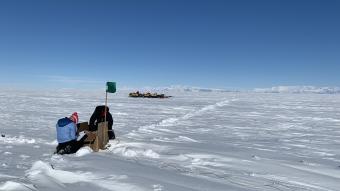Groundwater discovered in sediments buried deep under Antarctic ice
Mines professors, alum contribute to study that proves value of electromagnetic techniques in new polar environment

Mines Geophysics alumna Dr. Chloe Gustafson, now a postdoctoral researcher at Scripps Institution of Oceanography, and Dr. Kerry Key of Columbia University set up instrument electronics for a magnetotelluric installation on Whillans Ice Stream, West Antarctica. (Photo credit: Matt Siegfried/Colorado School of Mines)
A Colorado School of Mines professor and a Mines professor starting this fall contributed to new research led by a Mines alum that detected groundwater beneath an Antarctic ice stream for the first time.
The discovery confirms what researchers had already suspected but had been unable to verify until now.
Glaciologist Matt Siegfried, assistant professor of geophysics and faculty in the Hydrologic Science & Engineering program at Mines, and paleoglaciologist Ryan Venturelli, an assistant professor of geology and geological engineering starting at Mines this August, are two of six co-authors on the study, presented in the May 6 issue of the journal Science. The lead author is Mines Geophysics alum Chloe Gustafson ‘15, now a postdoctoral researcher at UC San Diego’s Scripps Institution of Oceanography.
“Our community has only worked to observe water in Antarctica at the interface between a glacier and the sediment or rocks underneath it,” Siegfried said. “Now we have to think about groundwater up-to a mile deep—a water reservoir many times larger than anything we have previously considered.”
A team of scientists from Scripps Institution of Oceanography and Columbia University’s Lamont-Doherty Earth Observatory led the project. Researchers measured the groundwater during the 2018-2019 Antarctic field season by using an electromagnetic (EM) method called magnetotellurics. It was the first time the method had been used to search for groundwater beneath a fast-moving ice stream, a glacial feature that transfers large volumes of ice from central Antarctica to the Southern Ocean.
In the last decade, airborne electromagnetic techniques have been used to image shallow groundwater in the upper 100 to 200 meters (328 to 656 feet) beneath thin glaciers and permanently frozen areas of the McMurdo Dry Valleys. But those techniques can only see through about 350 meters (1,148 feet) of ice.
The Whillans Ice Stream, where Gustafson and colleagues collected the data, measures about 800 meters (2,625 feet) thick. Their new data fill in a wide gap between those previous deep and shallow data sets.
“Ice streams are important because they funnel about 90 percent of Antarctica’s ice from the interior out to the margins,” Gustafson said. Groundwater at the base of these ice streams can affect how they flow, thus potentially influencing how ice is transported off the Antarctic continent.
The team imaged only one ice stream, but there are dozens of ice streams and outlet glaciers across the Antarctic ice sheet. “It suggests that there is probably groundwater beneath more Antarctic ice streams,” Gustafson said.
“Carbon transformed by microbial communities in sediments deep below the ice sheet can be transported by this groundwater and may eventually make its way to subglacial lakes where it can fuel the unique, isolated ecosystems that exist there,” Venturelli said.
The National Science Foundation and Columbia University Electromagnetic Methods Research Consortium supported this study as part of the Subglacial Antarctic Lakes Scientific Access project.
Co-authors included Helen Amanda Fricker, a Scripps glaciologist and co-director of the Scripps Polar Center; Kerry Key, an associate professor of earth and environmental sciences at Columbia University and a Scripps Oceanography alumnus; Paul Winberry, Central Washington University; and Alexander B. Michaud, Bigelow Laboratory for Ocean Sciences.
Access the full study, "A dynamic saline groundwater system mapped beneath an Antarctic ice stream," at science.org/doi/10.1126/science.abm3301.




